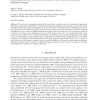Free Online Productivity Tools
i2Speak
i2Symbol
i2OCR
iTex2Img
iWeb2Print
iWeb2Shot
i2Type
iPdf2Split
iPdf2Merge
i2Bopomofo
i2Arabic
i2Style
i2Image
i2PDF
iLatex2Rtf
Sci2ools
JCNS
1998
1998
Synchronization and Oscillatory Dynamics in Heterogeneous, Mutually Inhibited Neurons
Abstract. We study some mechanisms responsible for synchronous oscillations and loss of synchrony at physiologically relevant frequencies
10-200 Hz
in a network of heterogeneous inhibitory neurons. We focus on the factors that determine the level of synchrony and frequency of the network response, as well as the e ects of mild heterogeneity on network dynamics. With mild heterogeneity, synchrony is never perfect and is relatively fragile. In addition, the e ects of inhibition are more complex in mildly heterogeneous networks than in homogeneous ones. In the former, synchrony is broken in two distinct ways, depending on the ratio of the synaptic decay time to the period of repetitive action potentials
s=T
, where T can be determined either from the network or from a single, self-inhibiting neuron. With s=T 2, corresponding to large applied current, small synaptic strength or large synaptic decay time, the e ects of inhibition are largely tonic and heterogeneous neurons spike relativ...
| Added | 22 Dec 2010 |
| Updated | 22 Dec 2010 |
| Type | Journal |
| Year | 1998 |
| Where | JCNS |
| Authors | John A. White, Carson C. Chow, Jason Ritt, Cristina Soto-Treviño, Nancy Kopell |
Comments (0)

